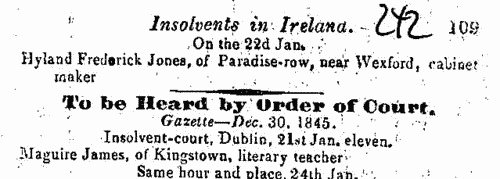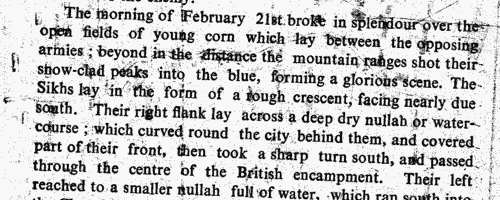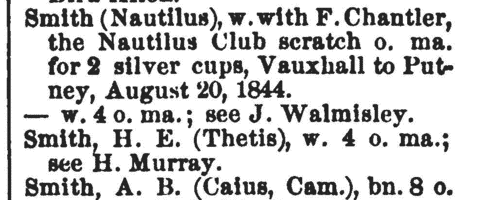Godby Surname Ancestry ResultsOur indexes 1000-1999 include entries for the spelling 'godby'. In the period you have requested, we have the following 142 records (displaying 81 to 90): Single Surname Subscription | | | Buying all 142 results of this search individually would cost £816.00. But you can have free access to all 142 records for a year, to view, to save and print, for £100. Save £716.00. More... |
These sample scans are from the original record. You will get scans of the full pages or articles where the surname you searched for has been found. Your web browser may prevent the sample windows from opening; in this case please change your browser settings to allow pop-up windows from this site. Scottish postal workers
(1841)
Officials and clerks of the Scottish Post Office are listed in the Royal Kalendar.GODBY. Cost: £6.00.  | Sample scan, click to enlarge

| Members of the Phonographic Corresponding Society
(1843)
The Phonotypic Journal, published weekly, contains lists of new members of the Phonographic Corresponding Society, alterations (such as changes of address), and lists of contributions to the Fund for purchasing a Phonotypic Fount. The lists of new members give full name (surname first) and address.GODBY. Cost: £6.00.  | Sample scan, click to enlarge

| New Members of the Phonographic Corresponding Society
(1844)
The Phonotypic Journal, published weekly, contains lists of new members of the Phonographic Corresponding Society, alterations (such as changes of address), and lists of contributions to the Fund for purchasing a Phonotypic Fount. The lists of new members give full name (surname first) and address. This index includes the new members, the changes of address, and names (such as 'care of') occurring in the addresses.GODBY. Cost: £6.00.  | Sample scan, click to enlarge

| Deaths, Marriages, News and Promotions
(1845)
Death notices and obituaries, marriage and birth notices, civil and military promotions, clerical preferments and domestic occurrences, as reported in the Gentleman's Magazine. Mostly from England and Wales, but items from Ireland, Scotland and abroad.
GODBY. Cost: £4.00.  | Sample scan, click to enlarge

| Inhabitants of Derbyshire
(1846)
Samuel Bagshaw's Derbyshire directory lists traders, farmers and private residents in the county by town, parish and/or township.GODBY. Cost: £6.00.  | Sample scan, click to enlarge

| Insolvents in Ireland
(1846)
Perry's Bankrupt and Insolvent Gazette, issued monthly, included lists of insolvencies and stages in the process whereby the insolvents petitioned for release from debtors' prison. The insolvent is generally referred to by name (surname first), address and trade. This is the index to the names of Irish insolvents, from the issues from January to December 1846.GODBY. Cost: £6.00.  | Sample scan, click to enlarge

| The Edinburgh Gazette
(1846)
The Edinburgh Gazette is the official publication in which various Scottish legal notices are issued, as well as promotions and casualty lists for the British army as a whole, and brief lists of English bankrupts. The key source for tracing details of Scottish bankruptcies, insolvencies, and dissolutions of business partnerships.GODBY. Cost: £6.00.  | Sample scan, click to enlarge

| British Army officers in the annexation of the Punjab
(1845-1849)
By 1845 the Sikh state of Lahore was the remaining substantial military power in the Indian sub-continent outside British rule. Its khalsa army was well equipped, disciplined, tenacious and had three European officers among its commanders. The sikhs controlled not only the Punjab, but Pathan tribes as far as the border with Afghanistan, and the whole of Kashmir. The river Sutlej formed the boundary between the Sikh state and British India. In early December 1845 the Sikh army crossed the Sutlej and invested the British garrisons at Ferozepore; 13 December 1845 the British declared war. After defeat in a series of battles, at Moodkee (18-21 December), Ferozeshah (21-22 December); Budhowal and Aliwal (23 December, 28 January); and Sobraon (10 February 1846), the state of Lahore submitted to the Treaty of Lahore, ceding the Punjab between the Sutlej and the Beas, Kashmir, and paying half a crore of rupees. The state of Lahore itself continued under the durbar as a British protectorate during the minority of the young maharajah; and the Sikh army was put under British command. Kashmir was sold by the British to the ruler of Jammu for a crore, and the submission of Kashmir to Jammu was effected by a Sikh force under British officers. British garrisons were placed in the Punjab, but the fort at Multan refused to submit, and had to be besieged. During the siege a Sikh regiment defected to join other khalsa remnants, in defiance of the durbar at Lahore, and raised a rebellion (August 1848 to January 1849). Battles at Chillianwalla (13 January 1849) and Gujerat (21 February 1849) destroyed the Sikh army. The British then annexed the whole of the Punjab, incorporating it into British India. This account of the Annexation of Punjab by Arthur D. Innes and General Charles Gough was published in 1897, but with a poor index; we have remedied that. The account also includes a description of the battles of Maharajapore and Puniar (29 December 1843) by which the army of Gwalior was destroyed. GODBY. Cost: £6.00.  | Sample scan, click to enlarge

| Gentlemen amateur rowers
(1835-1851)
Rowing was one of the English sports covered in detail in the pages of Bell's Life in London, and from these was compiled a compendium called the Aquatic Oracle. The text is divided into two main parts: Gentlemen Amateurs and Watermen. All the entries are cross-referenced, and use these abbreviations: w., won; l., lost; b., beat; bn., beaten; sc. ma., scullers' match; o. ma., oars match; do. sc. ma., double scullers' match; 4 o.ma., 4 oars match; 8 o. ma., 8 oars match; sk., stroke; cox., coxswain; as., a side; Oxon., Oxonian; V. to P., Vauxhall to Putney; W. to P., Westminster to Putney; P. to M., Putney to Mortlake; M. to P., Mortlake to Putney; dis., distance.GODBY. Cost: £6.00.  | Sample scan, click to enlarge

|  Inhabitants of Newington in Surrey
(1851) Inhabitants of Newington in Surrey
(1851)
The 1851 census return for St Mary Newington, Surrey, registration district: St Peter Walworth sub-district: enumeration district 17: described as: "All that Part of the Parish of St. Mary Newington, which Comprises The North side of Walworth Common from Queens Row to Walworth Road, East side of Walworth Road to Trafalgar St., Including Church Terrace, Peacock Terrace to Peacock St., Kings Row (both sides), Mount St. (both sides), Horsley St. and Little Mount St." This area lay in the ecclesiastical district of St Peter Walworth, and in the borough of Lambeth. HO 107/1567. The addresses listed in the actual returns are 1 to 3 Walworth Common Road; 1 to 23 Horsley Street; 1 to 5 Port Place; 1 to 5 Red Lion Street; Red Lion public house; 1 to 20 Mount Street (including School House); 1 to 10 Little Mount Street; 27 to 40 Beckford Row; 1 to 8 Church Terrace; 1 to 16 Peacock Terrace; 1 and 2 Sutherland Mews; and 1 to 28 Kings Row.GODBY. Cost: £4.00.  | Sample scan, click to enlarge

|
Research your ancestry, family history, genealogy and one-name study by direct access to original records and archives indexed by surname.
|













